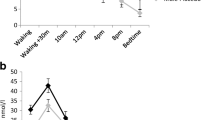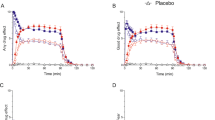Abstract
Objective: Serotonergic system contributes to the regulation of hypothalamus-pituitary-adrenal axis. In humans, serotonergic agonists increase PRL, ACTH, and cortisol, while serotonin (5HT) influence on GH is controversial. Central 5HT activity and neuroendocrine function change during lifespan. Design: To clarify the neuroendocrine response to 5HT across lifespan, we assessed ACTH, cortisol, DHEA, PRL, and GH responses to citalopram (CT) in young adults (YA) (no.=12, 29.2±1.7 yr mean±SEM), middle aged (MA) (no.=12, 54.3±0.9 yr), and elderly (ES) (no.=12, 69.3±0.9 yr) males. All the subjects received placebo (saline iv over 120 min) or CT (20 mg iv over 120 min). Blood samples were taken every 15 min up to 240 min. Results: During placebo, ACTH, cortisol, GH, and PRL were similar in all groups while DHEA showed an age-dependent reduction from middle age (p<0.001). During CT, ACTH, and cortisol were higher than during placebo in YA (p<0.05) and even more in MA (p<0.01 vs placebo, p<0.05 vs YA); in ES, the increase of both ACTH and cortisol (p<0.05 vs placebo) was lower than in MA (p<0.05) and higher than in YA (p<0.05 for cortisol only). No changes were observed for DHEA, GH, and PRL in any group. Conclusions: Corticotrope response to CT is age-dependent in normal men, being amplified starting from middle age, suggesting precocious changes in the serotonergic neuroendocrine control during lifespan. CT is a useful tool to evaluate the age-dependent serotonergic function in humans.
Similar content being viewed by others
References
Andrews MH, Kostaki A, Setiawan E, et al. Developmental regulation of the 5-HT7 serotonin receptor and transcription factor NGFI-A in the fetal guinea-pig limbic system: influence of GCs. J Physiol 2004, 555:659–70.
Lowry CA. Functional subsets of serotonergic neurones: implications for control of the hypothalamic-pituitary-adrenal axis. J Neuroendocrinol 2002, 14:911–23.
Erdeljan P, MacDonald JF, Matthews SG. Glucocorticoids and serotonin alter glucocorticoid receptor (GR) but not mineralocorticoid receptor (MR) mRNA levels in fetal mouse hippocampal neurons, in vitro. Brain Res 2001, 896: 130–6.
Meaney MJ, Diorio J, Francis D, et al. Postanatal handling increases the expression of cAMP-inducible transcriptions factors in the rat hyppocampus: the effects of thyroid hormones and serotonin. J Neurosci 2004, 20: 3926–35.
Andrews MH, Matthews SG. Programming of the hypothalamo-pituitary-adrenal axis: serotonergic involvment. Stress 2004, 7: 15–27.
Dinan TG. Serotonin and the regulation of hypothalamic-pituitary-adrenal axis function. Life Sci 1996, 58: 1683–94.
Fuller RW, Snoddy HD. Serotonin receptor subtypes involved in the elevation of serum corticosterone concentration in rats by direct- and indirect-acting serotonin agonists. Neuroendocrinology 1990, 52: 206–11.
Heisler LK, Pronchuk N, Nonogaki K, et al. Serotonin activates the hypothalamic-pituitary-adrenal axis via serotonin 2c receptor strimulation. J Neurosci 2007, 27: 6956–64.
Bagdy G, Calogero AE, Aulakh CS, Szemeredi K, Murphy DL. Long-term cortisol treatment impairs behavioral and neuroendocrine responses to 5-HT1 agonists in the rat. Neuroendocrinology 1989, 50: 241–7.
Di Sciullo A, Bluet-Pajot MT, Mounier F, Oliver C, Schmidt B, Kordon C. Changes in anterior pitutitary hormone levels after serotonin 1A receptor stimulation. Endocrinology 127: 567–72.
Owens MJ, Knight DL, Ritchie JC, Nemeroff CB. The 5-hydroxytryptamine2 agonist, (±)-1 -(2,5-dimethoxy-4-bromophenyl)-2-aminopropane stimulates the hypothalamic-pituitary-adrenal (HPA) axis. I. Acute effects on HPA axis activity and corticotrophin-releasing factor-containing neurons in the rat brain. J Pharmacol Exp Ther 1991, 256: 787–94.
Power AC, Cowen PJ. Neuroendocrine challenge tests: assessment of 5-HT function in anxiety and depression. Mol Aspects Med 1992, 1: 205–20.
Raap DK, Van de Kar LD. Selective serotonin reuptake inhibitors and neuroendocrine function. Life Sci 1999, 65: 1217–35.
Lowe SL, Yeo KP, Teng L, et al. L-5-Hydroxytryptophan augments the neuroendocrine response to a SSRI. Psychoneuroendocrinology 2006, 31: 473–84.
Arora RC, Gulati A, Crayton JW. Aging and 3H-paroxetine binding in rat brain: effect of imipramine and tetrahydroacridine. Life Sci 1993, 52: 1767–75.
Yau JL, Kelly PA, Olsson T, Noble J, Seckl JR. Chronic amitriptyline administration increases serotonin transporter binding sites in the hyppocampus of aged rats. Neurosci Lett 1999, 261: 183–5.
Gross-Isseroff R, Salama D, Israeli M, Biegon A. Autoradiopgraphic analysis of age-dependent changes in serotonin 5-HT2A receptors of the human brain postmortem. Brain Res 1990, 19: 223–7.
Arranz B, Eriksson A, Mellerup E, Plenge P, Marcusson J. Effect of aging in human cortical pre- and postsynaptic serotonin binding sites. Brain Res 1993, 620: 163–6.
Wong D, Wagner H, Dannals R, et al. Effects of age on dopamine and serotonin receptors measured by positron emission tomography in living human brain. Science 1984, 226: 226: 1393–6.
Tauscher J, Verhoeff NP, Christensen BK, et al. Serotonin 5-HT1A receptor binding potential declines with age as measured by [11C]WAY-100635 and PET. Neuropsychopharmacology 2001 24: 522–30.
Sheline YI, Mintun MA, Moerlein SM, Snyder AZ. Greater loss of 5-HT(2A) receptors in midlife than in late life. Am J Psychiatry 2002, 159: 430–5.
Baeken C, D’Haenen H, Flamen P, et al. 123I-5-I-R91150, a new single-photon emission tomography ligand for 5-HT2A receptors: influence of age and gender in healthy subjects. Eur J Nucl Med 1998, 525: 1617–22.
Moller M, Jakobsen S, Gjedde A. Parametric and regional maps of free serotonin 5HT1A receptor sites in human brain as function of age in healthy humans. Neuropsychopharmacology 2007, 32: 1707–14.
McBride PA, Tierney H, DeMeo M, Chen JS, Mann JJ. Effects of age and gender on CNS serotonergic responsivity in normal adults. Biol Psychiat 1990, 27: 1143–55.
GelfinY, Lerer B, Lesch KP, Gorfine M, Allolio B. Complex effects of age and gender on hypothermic, adrenocorticotrophic hormone and cortisol responses to ipsapirone challenge in normal subjects. Psychopharmacology 1995, 120: 356–64.
Lerer B, Gillon D, Lichtenberg P, Gorfine M, Gelfin Y, Shapira B. Interrelationship of age, depression, and central serotonergic function: evidence from fenfluramine challenge studies. Int Psychogeriat 1996, 8: 83–102.
O’Hara R, Schröder CM, Mahadevan R, et al. Serotonin transporter polymorfism, memory, and hyppocampal volume in the elderly: association and interaction with cortisol. Mol Psychiatry 2007, 12: 544–55.
Seifritz E, Baumann P, Müller MJ, et al. Neuroendocrine effects of a 20-mg citalopram infusion in healthy males. A placebo-controlled evaluation of citalopram as 5-HT function probe. Neuropsychopharmacology 1996, 14: 253–63.
Henning J, Netter P. Oral application of citalopram (20 mg) and its usefulness for neuroendocrine challenge tests. Int J Neuropsychopharmacol 2002, 5: 67–71.
Attenburrow MJ, Mitter PR, Whale R, Terao T, Cowen PJ. Low-dose citalopram as a 5-HT neuroendocrine probe. Psychopharmacology (Berl) 2001, 155: 323–6.
Flory JD, Manuck SB, Perel JM, Muldoon MF. A comparison of d, I-fenfluramine and citalopram challenges in healthy adults. Psychopharmacology (Berl) 2004, 174: 376–80.
Bhagwagar Z, Hafizi S, Cowen PJ. Acute citalopram administration produces correlated increases in plasma and salivary cortisol. Psychopharmacology (Berl) 2002, 163: 118–20.
Pariante CM, Papadopoulos AS, Poon L, et al. Four day of citalopram increase suppression of cortisol secretion by prednisolone in healthy volunteers. Psychopharmacology (Berl) 2004, 177: 200–6.
Lotrich FE, Bies R, Muldoon MF, Manuck SB, Smith GS, Pollock BG. Neuroendocrine response to intravenous citalopram in healthy control subjects: pharmacokinetic influences. Psychopharmacology (Berl) 2005, 178: 268–75.
Bhagwagar Z, Whale R, Cowen PJ. State and trait abnormalities in serotonin function in major depression. Br J Psychiatry, 2002, 180: 24–8.
Kapitany T, Schindl M, Schindler SD, et al. The citalopram challenge test in patients with major depression and in healthy controls. Psychiatry Res 1999, 88: 75–88.
Pavlov EP, Harman SM, Chrousos GP, Loriaux DL, Blackman MR. Responses of plasma adrenocorticotropin, cortisol, and dehydroepiandrosterone to ovine corticotropin-releasing hormone in healthy aging men. J Clin Endocrinol Metab 1986, 62: 767–72.
Dodt C, Theine K, Uthgenannt D, Born J, Fehm HL. Basal secretory activity of the hypothalamo-pituitary-adrenocortical axis is enhanced in healthy elderly. An assessment during undisturbed night-time sleep. Eur J Endocrinol 1994, 131:443–50.
Van Cauter E, Leproult R, Kupfer DJ. Effetcs of gender and age on the levels and circadian rhythmicity of plasma cortisol. J Clin Endocrinol Metab 1996, 81: 2468–73.
Deuschle M, Gotthardt U, Schweiger U, et al. With aging in humans the activity of the hypothalamus-pituitary-adrenal system increases and its diurnal amplitude flattens. Life Sci 1997, 61: 2239–46.
Touitou Y, Sulon J, Bogdan A, et al. Adrenal circadian system in young and elderly human subjects: a comparative study. J Endocrinol 1982, 93: 201–10.
Waltman C, Blackman MR, Chrousos GP, Riemann C, Harman SM. Spontaneus and glucocorticoid-inhibited adrenocorticotropic hormone and cortisol secretion are similar in healthy young and old men. J Clin Endocrinol Metab 1991, 73: 495–502.
Dodt C, Dittmann J, Hruby J, et al. Different regulation of adrenocorticotropin and cortisol secretion in young, mentally healthy elderly and patients with senile dementia of Alzheimer’s type. J Clin Endocrinol Metab 1991, 72: 272–6.
Meijer OC, de Lange EC, Breimer DD, de Boer AG, Workel JO, de Kloet ER. Penetration of dexamethasone into brain glucocorticoid targets is enhanced in mdr1A P-glycoprotein knockout mice. Endocrinology 1998, 139: 1789–93.
Sherman B, Wysham C, Pfohl B. Age-related changes in the circadian rhythm of plasma cortisol in man. J Clin Endocrinol Meatb 1985, 61: 439–43.
Parker CR, Mixon RL, Brissie RM, Grizzle WE. Aging alters zonation in the adrenal cortex of men. J Clin Endocrinol Metab 1997, 82: 3898–901.
Mondelli V, Gianotti L, Picu A, et al. Neuroendocrine effects of citalopram infusion in anorexia nervosa. Psychoneuroendocrinology 2006, 31: 1139–48.
Lacroix A, Ndiaye N, Tremblay J, Hamet P. Ectopic and abnormal hormone receptors in adrenal Cushing’s syndrome. Endocr Rev 2001, 22: 75–110.
Parker CR Jr, Azziz R, Potter HD, Boots LR. Adrenal androgen production in response to adrenocorticotropin infusions in men. Endocr Res 1996, 22: 717–22.
Arvat E, Di Vito L, Lanfranco F, et al. Stimulatory effect of adrenocorticotropin on cortisol, aldosterone, and dehydroepiandrosterone secretion in normal humans: dose-response study. J Clin Endocrinol Metab 2000, 85: 3141–6.
Giordano R, Bo M, Pellegrino M, et al. Hypothalamus-pituitary-adrenal hyperactivity in human aging is partially refractory to stimulation by mineralocorticoid receptor blockade. J Clin Endocrinol Metab 2005, 90: 5656–62.
Goodwin GM, Murray CL, Bancroft J. Oral D-fenfluramine and neuroendocrine challenge: problems with the 30 mg dose in men. J Affect Disord 1994, 30: 117–22.
Ramasubbu R, Flint A, Brown G, Awad G, Kennedy S. Neurohormonal responses to D-fenfluramine in healthy elderly subjects. A placebo-controlled study. Psychoneuroendocrinology 2000, 25: 139–50.
Author information
Authors and Affiliations
Corresponding author
Rights and permissions
About this article
Cite this article
Berardelli, R., Margarito, E., Ghiggia, F. et al. Neuroendocrine effects of Citalopram, a selective serotonin re-uptake inhibitor, during lifespan in humans. J Endocrinol Invest 33, 657–662 (2010). https://doi.org/10.1007/BF03346666
Published:
Issue Date:
DOI: https://doi.org/10.1007/BF03346666




